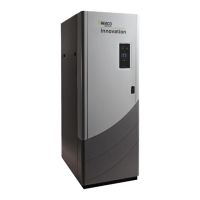Innovation - Edge [i] Installation, Operation, Maintenance Manual
CHAPTER 8 – WATER HEATER MANAGEMENT
OMM-0143_A • GF-216 • 9/6/2019 Technical Support • (800) 526-0288 • Mon-Fri, 8 am - 5 pm EST Page 119 of 170
Figure 8.6-3: Application Configuration Screen
The remaining WHM parameters are in Main Menu → Advanced Setup → WHM Cascade →
Operating Controls.
TABLE 8-6d: Operating Controls → Sequencing Control Parameters
Available Choices or Limits
Off, On - Outlet Temp or On - Avg
Temp
If either “On” option is chosen, WHM monitors the multi-unit system to detect if a “low-flow”
condition exists. If it does exists, WHM slowly shuts down one unit at a time in an attempt to
raise the Fire Rate of the remaining units. If the low-flow condition persists, and only a single
unit remains ignited, WHM will use the “Outlet Temperature Sensor” of the remaining ignited
unit to control the temperature. The Outlet Temperature Sensor is mounted in the individual
unit and drastically increases the response time to precisely control temperature.
For low flow applications, this parameter allows the unit to operate without excessive cycling.
This parameter specifies the valve position below which the unit plant will enter this mode
Determines the valve position that triggers the next unit to come on line
Determines the valve position that triggers the next unit to come off line.
The maximum number of units that will fire. For example: if there are 5 units, but this setting is
set to 3, the plant will not fire more than 3 units.
The time an open Isolation Valve will remain open once a unit has cycled off. When an ignited
unit is cycled off, its Isolation Valve will remain open for the specified time to dissipate residual
heat.
Controls the frequency of updates made to the Fire Rate sent to all units. This feature can be
used to slow down the rate of change of the Fire Rate of the WHM System.

